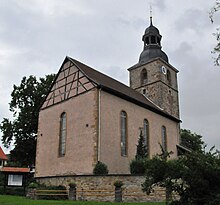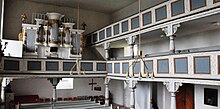To the Help of God Church (Queienfeld)
The main church of the Thuringian town Queienfeld , Zur-Hilfe-Gottes , is also one of its special sights.
The parish
The parishes of Westenfeld (since 1968) and Behrungen (since 1966) still belong to today's Protestant parish Queienfeld . There used to be independent parish offices in all three parishes. The (2010) about fifty evangelical Christians from the neighboring Catholic embossed Wolfmannshausen also belong to the parish Queienfeld. From the Reformation until 1966 Rentwertshausen was also part of the parish. In 1966 Rentwertshausen came to the Bibra parish as part of a regional reform , and Behrungen came to Queienfeld in return. Queienfeld and Westenfeld jointly run a church choir and other ecumenical events, e.g. B. Week of Prayer for Christian Unity and World Day of Prayer for Women. On the first Sunday in May the parish celebrates one of the spiritual highlights of the year, the forest service at the Lutherlinde.
history
predecessor
There is evidence that in 1122 on the summit of Queienberg, north of Queienfeld, there was the richly furnished Marienkapelle with cemetery, the destination of the famous Queienfeld pilgrimage . When the Grimmenthal pilgrimage had overtaken her, she was visited for a while after the Reformation, then fell into disrepair and was removed. Today only a wooden cross reminds of them. The "Queienberghütte", a popular excursion destination, is located nearby today. From the summit of the Queienberg you have a wonderful view.
Christophorus Chapel and Church for God's Help
The altar niche of today's church in the center of the village under the old fortified tower is probably the former chapel of St. Christophorus: Late Gothic tracery , exposed religious wall paintings and a baptismal font with the year 1546 could be evidence of this. In 1720 the nave was built on the existing church tower . The ensemble is located within the walls of a former fortified church . A part of the moat that is still in good condition is evidence of the fortification in the center of the village. The church was named In the Help of God. Currently (2010) the church is without patronage .
Interior fittings
pulpit
If you enter the church through the smaller of the two northern entrance doors, the first impression is the view of the high pulpit from 1731. Today, the steep staircase is no longer used for every sermon , but only on special occasions. Originally the pulpit was housed together with the organ in the (too) small chancel , so that from 1970 to 1974 a major renovation of the church was carried out, resulting in the current location of the pulpit and organ.
The pulpit is decorated with half-reliefs of the evangelists . The sound cover is decorated with a gold-colored crown above which the risen Christ rises with the victory flag. The pulpit is not hanging on the wall or a pillar of the nave, as is usually the case, but stands on a pillar in the middle under the pulpit, which is adorned by a climbing plant. On the wall under the pulpit there is an old Apostle's cross , a second copy is on the north wall of the chancel . Directly under the pulpit is a baptismal font from 1546.
altar
The chancel (rather just an altar niche, the former chapel) is located on the west side of the nave. It takes up only about a third of the width of the nave. The modern stained glass window with a stylized crucifixion scene is impressive . The window is a donation from a former parishioner. The old frescoes , which were only discovered and exposed during the renovation work at the beginning of the 1970s, as well as the Apostles' Cross on the same wall are of interest in art history .
Gallery and organ
The north wall of the church is dominated by a two-story gallery , the lower floor of which houses the beautiful organ on the east side. A painting by the Saalfeld church musician Wilhelm Köhler, who was born here in Queienfeld, hangs above the organ manual. One of Köhler's main works is the setting of Psalm 100. Verse 4 of this psalm is written on a wooden panel above the entrance door of the church. It was installed on January 25, 1844 to commemorate the 300th anniversary of the introduction of the Lutheran Reformation in the Henneberger Land .
Personalities
- Wilhelm Köhler (1852–1924), church musician
Web links and sources
- Queienfeld on the website of the municipality of Grabfeld. Retrieved April 23, 2020 .
- The church on the website of the church district. Retrieved April 23, 2020 .
- Text material from the Queienfeld rectory for the Meiningen church district book, presented by Pastor Wolfgang Hochstrate
Individual evidence
- ↑ Entry on the missing Queienfeld churchyard fortifications in the private database "Alle Burgen". Retrieved April 23, 2020.
Coordinates: 50 ° 27 ′ 1.5 ″ N , 10 ° 27 ′ 14.4 ″ E




